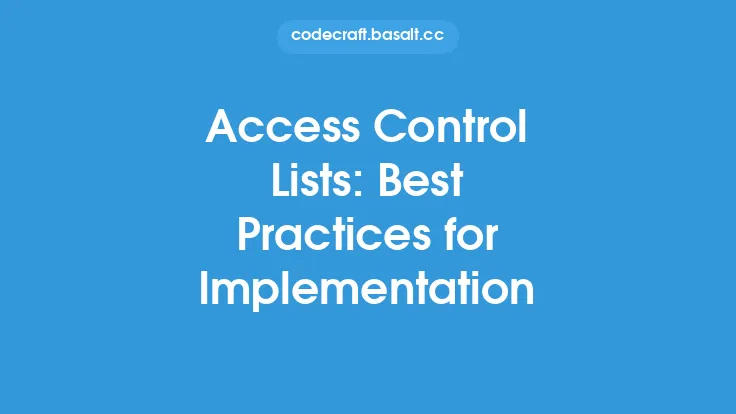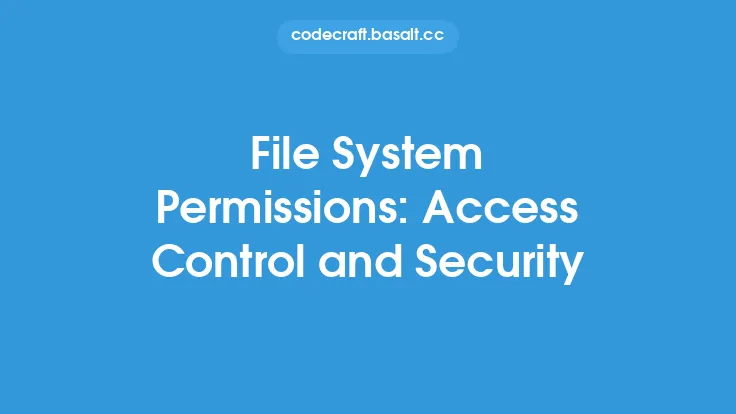Access control lists (ACLs) are a fundamental concept in operating system security, allowing administrators to control access to resources such as files, directories, and network shares. In essence, ACLs are a list of permissions associated with a particular resource, defining which users or groups have access to it and what actions they can perform. This article will delve into the world of ACLs, exploring their structure, types, and applications in operating systems.
Introduction to Access Control Lists
An ACL is a data structure that contains a set of access control entries (ACEs), each specifying a user or group, the permissions they have, and the type of access (allow or deny). The ACL is associated with a particular resource, such as a file or directory, and is used to determine whether a user has the necessary permissions to access or modify the resource. ACLs can be used to enforce a wide range of security policies, from simple read/write permissions to complex rules governing access to sensitive data.
Structure of Access Control Lists
An ACL typically consists of a header and a series of ACEs. The header contains information about the ACL, such as its size and the number of ACEs it contains. Each ACE is composed of several fields, including:
- A flag indicating whether the ACE is an allow or deny entry
- A set of permissions (e.g., read, write, execute) that are being allowed or denied
- A security identifier (SID) or user ID (UID) that identifies the user or group to which the ACE applies
- An optional set of inheritance flags that control how the ACE is inherited by child objects
Types of Access Control Lists
There are several types of ACLs, each with its own specific characteristics and applications. Some of the most common types of ACLs include:
- Discretionary access control lists (DACLS): These are the most common type of ACL and are used to control access to resources based on user identity and group membership.
- Mandatory access control lists (MACLS): These are used in systems that require a higher level of security and are based on a set of rules that are enforced by the operating system.
- Role-based access control lists (RBACLS): These are used in systems where access is based on a user's role or function within an organization.
Applications of Access Control Lists
ACLs have a wide range of applications in operating systems, including:
- File system security: ACLs are used to control access to files and directories, ensuring that only authorized users can read, write, or execute files.
- Network security: ACLs are used to control access to network resources, such as shares and printers.
- System security: ACLs are used to control access to system resources, such as registry keys and system files.
Implementing Access Control Lists
Implementing ACLs in an operating system requires a thorough understanding of the underlying security architecture. This includes:
- Defining the ACL structure and format
- Developing algorithms for evaluating ACLs and determining access
- Integrating ACLs with other security mechanisms, such as authentication and authorization
- Providing tools and interfaces for administrators to manage and configure ACLs
Best Practices for Using Access Control Lists
To get the most out of ACLs, administrators should follow best practices such as:
- Keeping ACLs simple and easy to understand
- Using inheritance to minimize the number of ACEs
- Regularly reviewing and updating ACLs to ensure they remain effective
- Using tools and scripts to automate ACL management tasks
Common Challenges and Limitations
While ACLs are a powerful tool for controlling access to resources, they can also present challenges and limitations. Some common issues include:
- Complexity: ACLs can be complex and difficult to manage, particularly in large and distributed systems.
- Performance: Evaluating ACLs can impact system performance, particularly if the ACLs are large or complex.
- Scalability: ACLs can become unwieldy in large systems, making it difficult to manage and maintain them.
Conclusion
In conclusion, access control lists are a fundamental component of operating system security, providing a flexible and powerful mechanism for controlling access to resources. By understanding the structure, types, and applications of ACLs, administrators can effectively use them to enforce security policies and protect sensitive data. While ACLs present challenges and limitations, following best practices and using tools and scripts to automate ACL management tasks can help minimize these issues and ensure the effective use of ACLs in operating systems.





